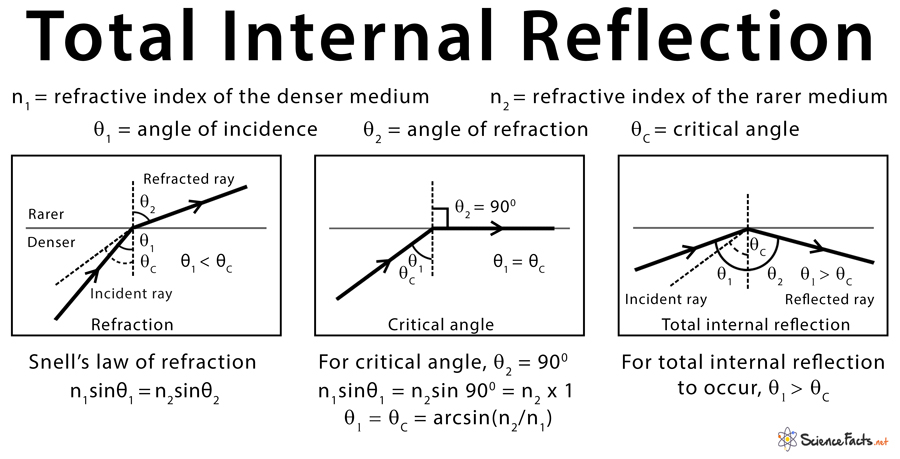Total Internal Reflection
Definition: What is Total Internal Reflection?
Total internal reflection (TIR) is the phenomenon in which a ray of light traveling from a denser medium to a rarer medium is reflected in the denser medium at the interface between the two media. Total internal reflection occurs when the angle of incidence is greater than a certain angle, called a critical angle. If the angle of incidence is equal to or less than the critical angle, then TIR will not occur [1-3].
Conditions for Total Internal Reflection
There are two necessary conditions for total internal reflection.
- The ray of light must be traveling from a denser medium to a rarer medium; i.e., the refractive index of the first medium must be higher than the second.
- The angle of incidence must be greater than the critical angle, which can be determined from Snell’s law.
Equation and Formula Used in Total Internal Reflection
Applications of Total Internal Reflection
- Diamond: Diamond has a very high refractive index (n~2.42). Light falling on a diamond undergoes refraction. However, because of its shape and high refractive index, the light will pass through several reflections inside the surface before exiting. TIR is the reason why diamonds have a very sparkling and shiny appearance.
- Fiber optic: Fiber optic cable is made up of a core (higher refractive index) and a cladding (lower refractive index). Light passing through the core will undergo several internal reflections as its angle of incidence is greater than the critical angle. An example of an instrument using a bunch of optical fibers is an endoscope.
- Safety reflector: A safety reflector consists of several prisms. They are arranged in such a way that light falling on it will undergo several total internal reflections before refracting out of the direction it came inside.
- Periscope: Periscope is used in a submarine. A periscope consists of two right-angle triangular prisms. They are arranged in such a way that light entering at 90° through the first prism is reflected at 45°, which is higher than the critical angle for glass-air material pair. This process is repeated for the second prism until the light reaches the eyepiece. In this way, objects outside water can be viewed from inside the submarine.
- Total Internal Reflection Microscopy (TIRM): TIRM is an optical technique for monitoring the instantaneous separation distance between a microscopic sphere and a flat plate. Evanescent waves are used to illuminate the sphere that has a refractive index different from the plate. The intensity of the scattered light is used to determine this distance. When light hits the sphere, some of the evanescent waves are scattered by the sphere. This phenomenon is known as frustrated total internal reflection. An extension of TIRM is total internal reflection fluorescence microscopy (TIRFM), which is an essential tool of biophysics and quantitative biology.
Example of Total Internal Reflection in Nature
Mirages are a common example of total internal reflection in deserts where the density of air varies because the sun’s rays heat the surface. A ray of light from an object passing through the denser cold air will reflect from the rarer hot air that is close to the surface. As a result, an observer seeing an object from a distance will see its reflection on the ground.
Article was last reviewed on Tuesday, January 21, 2020








